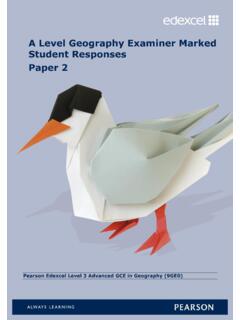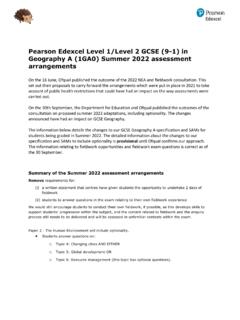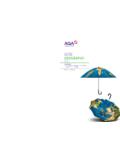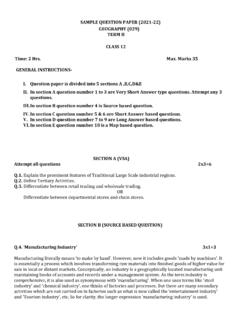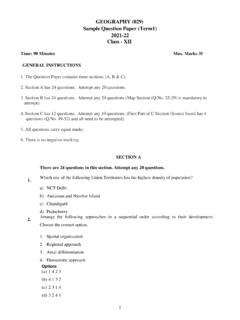Transcription of Mark scheme: Paper 2 Human geography and geography ...
1 AS geography 7036/2 Human geography and The geography Fieldwork Investigation (New) Final Mark Scheme 7036 June 2017 Version/Stage: Mark schemes are prepared by the Lead Assessment Writer and considered, together with the relevant questions, by a panel of subject teachers. This mark scheme includes any amendments made at the standardisation events which all associates participate in and is the scheme which was used by them in this examination. The standardisation process ensures that the mark scheme covers the students responses to questions and that every associate understands and applies it in the same correct way. As preparation for standardisation each associate analyses a number of students scripts. Alternative answers not already covered by the mark scheme are discussed and legislated for. If, after the standardisation process, associates encounter unusual answers which have not been raised they are required to refer these to the Lead Assessment Writer.
2 It must be stressed that a mark scheme is a working document, in many cases further developed and expanded on the basis of students reactions to a particular Paper . Assumptions about future mark schemes on the basis of one year s document should be avoided; whilst the guiding principles of assessment remain constant, details will change, depending on the content of a particular examination Paper . Further copies of this mark scheme are available from Copyright 2017 AQA and its licensors. All rights reserved. AQA retains the copyright on all its publications. However, registered schools/colleges for AQA are permitted to copy material from this booklet for their own internal use, with the following important exception: AQA cannot give permission to schools/colleges to photocopy any material that is acknowledged to a third party even for internal use within the centre. MARK SCHEME AS geography 7036/2 JUNE 2017 Level of response marking instructions Level of response mark schemes are broken down into levels, each of which has a descriptor.
3 The descriptor for the level shows the average performance for the level. There are marks in each level. Before you apply the mark scheme to a student s answer read through the answer and annotate it (as instructed) to show the qualities that are being looked for. You can then apply the mark scheme. Step 1 Determine a level Start at the lowest level of the mark scheme and use it as a ladder to see whether the answer meets the descriptor for that level. The descriptor for the level indicates the different qualities that might be seen in the student s answer for that level. If it meets the lowest level then go to the next one and decide if it meets this level, and so on, until you have a match between the level descriptor and the answer. With practice and familiarity you will find that for better answers you will be able to quickly skip through the lower levels of the mark scheme. When assigning a level you should look at the overall quality of the answer and not look to pick holes in small and specific parts of the answer where the student has not performed quite as well as the rest.
4 If the answer covers different aspects of different levels of the mark scheme you should use a best fit approach for defining the level and then use the variability of the response to help decide the mark within the level, ie if the response is predominantly level 3 with a small amount of level 4 material it would be placed in level 3 but be awarded a mark near the top of the level because of the level 4 content. Step 2 Determine a mark Once you have assigned a level you need to decide on the mark. The descriptors on how to allocate marks can help with this. The exemplar materials used during standardisation will help. There will be an answer in the standardising materials which will correspond with each level of the mark scheme. This answer will have been awarded a mark by the Lead Examiner. You can compare the student s answer with the example to determine if it is the same standard, better or worse than the example. You can then use this to allocate a mark for the answer based on the Lead Examiner s mark on the example.
5 You may well need to read back through the answer as you apply the mark scheme to clarify points and assure yourself that the level and the mark are appropriate. Indicative content in the mark scheme is provided as a guide for examiners. It is not intended to be exhaustive and you must credit other valid points. Students do not have to cover all of the points mentioned in the Indicative content to reach the highest level of the mark scheme. An answer which contains nothing of relevance to the question must be awarded no marks. 3 MARK SCHEME AS geography 7036/2 JUNE 2017 Annotation Description ? Questionable point [ Start of creditworthy passage ] End of creditworthy passage ^ Missing detail / elaboration needed AO1 Assessment Objective 1 AO2 Assessment Objective 2 Highlight Use to highlight important phrases / examples or as a side-bar to highlight a creditworthy passage JUST Just at the level awarded or point just awarded L1 Level 1 L2 Level 2 L3 Level 3 L4 Level 4 TV Too vague NAQ Not Answering the Question NC Not creditworthy Not Relevant Wavy-line use on side-bar to identify text that is not relevant On Page Comment Text box SEEN To show that work has been read and used on unanswered pages H Line Use to underline incorrect text Tick Use on point mark questions where creditworthy 4 MARK SCHEME AS geography 7036/2 JUNE 2017 Qu Part Marking guidance Total marks 01 1 Which of the following data sources involves a qualitative approach to determine people s lived experience of a place?
6 B 1 AO1=1 01 2 Below is a list of quotes by people about the place where they live. Which quote best describes an exogenous factor affecting their sense of place? B 1 AO1=1 01 3 Describe one way in which corporate bodies can try to influence or create specific place meanings. Mark scheme Point marked Award 1 mark for each relevant point with extra mark(s) for developed points (d). Award 1 mark for the example of strategy given. Notes for answers The answer requires only one strategy by a corporate body. One mark is available for naming the strategy with subsequent marks awarded for developing the strategy and outlining how specific place meanings are created. The answer does not require a specific strategy. If they have done more than one strategy, credit the best example. Corporate bodies can try to manipulate perceptions of place to make it more appealing to visitors/residents. This can be through rebranding.(1) Promotion can be done using slogans, adverts and brochures to advertise the new place meaning.
7 (1) Eg Hull was awarded Hull City of Culture 2017 by the Department of Culture and Media (1). This was to promote arts and culture (1) to create a sense of regeneration and celebration of art in Hull (1). The event is for one year and uses different slogans across the year such as Roots and Routes (1) to celebrate migration and change in Hull (1) This means that Hull s reputation grows (1) this might attract more investment both locally and nationally (1)(d). 3 AO1=3 5 MARK SCHEME AS geography 7036/2 JUNE 2017 01 4 Contrast the usefulness of Fig 1a and 1b in representing the physical geography of the area North / North-East of Skelwith Bridge. AO3 Interpretation of, and comparison between, the two maps. Evaluation of the usefulness of the two maps for showing features of physical geography . Mark scheme Level 2 (4 6 marks) AO3 Clear evaluation of the qualitative and quantitative evidence provided, which makes appropriate use of data in support.
8 Clear connection(s) between different aspects of the data and evidence. Level 1 (1 3 marks) AO3 Basic evaluation of the qualitative and quantitative evidence provided, which makes appropriate use of data in support. Basic connection(s) between different aspects of the data and evidence. Max Level 1 if there is no mention of physical geography or no contrast of the two sources. Notes for answers The question requires a contrast between the two maps and an evaluation of their usefulness in showing features of physical geography (relief, drainage). Responses should identify features of physical geography evident in the two maps and contrast the maps in terms of their usefulness in showing these features. AO3 The area directly to the North of Skelwith Bridge has higher relief to the west but is flatter to the East. This is clearly depicted on the OS map but is not shown on the Wainwright map. The area South of Loughrigg Fell is clearly very steep and mountainous. Loughrigg fell reaches a height of 335m according to the OS map.
9 The actual height is not depicted on the Wainwright sketch There is a large lake (tarn) called Loughrigg Tarn that measures across. This is also shown on the sketch map but it appears much larger in comparison to other features Many streams flow out of the Tarn into the River Brathay. These are visible on the OS map but not evident on the sketch map Wainwright s sketch has a 3D element which clearly represents the shape of the mountains / relief clearly and the 6 AO3=6 6 MARK SCHEME AS geography 7036/2 JUNE 2017 summits are clearly visible. The contours are very close on the OS map so it is difficult to visualise the relief. The OS map is much more complete in recording physical features as there is many omissions from the sketch map Responses may also observe that the sketch map is much older using imperial measurements and therefore perhaps out of date. Responses may focus on distortion in the sketch map so some things appear larger (eg the tarn), whilst others are smaller.
10 Usefulness in terms of the audience for example the sketch may be useful for walkers as it has annotations to help and important/interesting features are labelled. 01 5 Figure 2 shows a regeneration scheme in Sheffield. With reference to Figure 2, assess the extent to which money and investment might change people s lived experience in this place. AO1 Knowledge and understanding of how money and investment can alter people s lived experience. Understanding the impact of regeneration AO2 Application of knowledge and understanding to be able to assess the impact on Park Hill by interpreting the evidence in Figure 2. Demonstrating the extent to which people s lived experience has changed Mark scheme Level 3 (7 9 marks) AO1 Demonstrates detailed knowledge and understanding of the concepts, interactions and change. Detailed knowledge and understanding of the changing characteristics. AO2 Demonstrates detailed application of knowledge and understanding to the novel situation and the extent to which this may have caused change.











